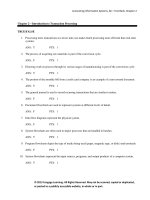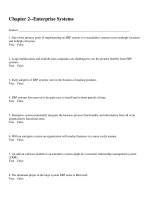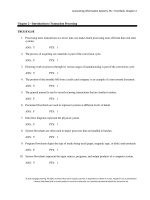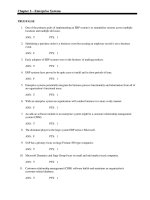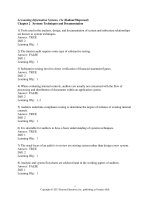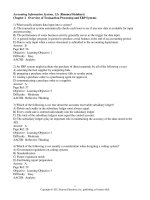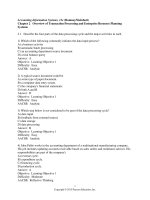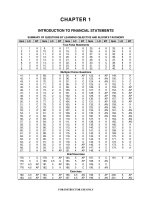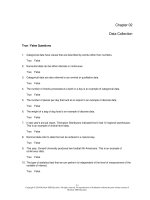Business driven information systems 5th edition baltzan test bank
Bạn đang xem bản rút gọn của tài liệu. Xem và tải ngay bản đầy đủ của tài liệu tại đây (556.9 KB, 133 trang )
Chapter 02 Test Bank
Student:_________________________________________________________________
1. One of the most important and challenging questions confronting
managers today is how to lay the foundation for tomorrow’s success while
competing to win in today’s business environment.
True False
2. Analytics is the science of fact-based decision making.
True False
3. At the operational level, employees are continuously evaluating
company operations to hone the firm’s abilities to identify, adapt to,
and leverage change.
True False
4. At the operational level, employees develop, control, and maintain
core business activities required to run the day-to-day operations.
True False
5. Operational decisions are considered structured decisions.
True False
6. Asking how many employees are out sick is a type of operational
question.
True False
7. The structure of a typical organization is similar to a pyramid, with
different levels that require one consistent type of information to
assist with all managerial decision making.
True False
8. Operational decisions, or semistructured decisions, arise in
situations where established processes offer potential solutions.
True False
9. At the strategic decision-making level, employees develop, control,
and maintain core business activities.
True False
10. Unstructured decisions occur in situations in which no procedures or
rules exist to guide decision makers towards the correct choice.
True False
11. Strategic decisions are highly structured decisions.
True False
12. Key performance indicators can focus on external and internal
measurements.
True False
13. The proportion of the market that a firm captures is called market
share.
True False
14. A project is a temporary activity a company undertakes to create a
unique product, service, or result.
True False
15. Metrics are temporary activities a company undertakes to create a
unique product, service, or result.
True False
16. Metrics are measurements that evaluate results to determine whether a
project is meeting its goals.
True False
17. Return on investment indicates the earning power of a project.
True False
18. Effectiveness MIS metrics include throughput, transaction speed, and
system availability.
True False
19. Measuring the amount of website traffic is the best way to determine
an organization’s success.
True False
20. Efficiency MIS metrics include throughput, speed, and availability.
True False
21. Effectiveness MIS metrics measure the impact MIS has on business
processes and activities, including customer satisfaction and customer
conversion rates.
True False
22. Efficiency MIS metrics measure the impact MIS has on business
processes and activities, including customer satisfaction and customer
conversion rates.
True False
23. Best practices are the most successful solutions or problem-solving
methods that have been developed by a specific organization or industry.
True False
24. MIS support systems rely on models for computational and analytical
routines that mathematically express relationships among variables.
True False
25. Benchmarks are baseline values the system seeks to attain.
True False
26. A model is a simplified representation or abstraction of reality.
True False
27. Managers use transactional information when making structured
decisions at the operational level.
True False
28. Streamlining information encompasses all of the information contained
within a single business process or unit of work, and its primary purpose
is to support the performing of daily operational or structured
decisions.
True
False
29. The manipulation of information to create business intelligence in
support of strategic decision making is referred to as OLTP or online
transaction processing.
True False
30. Source documents are simplified representation or abstraction of
reality.
True False
31. Source documents are the original transaction records.
True False
32. Sensitivity analysis, what-if analysis, optimization analysis, and
market basket analysis are the common DSS analysis techniques.
True False
33. Granularity refers to the level of detail in the model or the
decision-making process.
True False
34. Visualization produces graphical displays of patterns and complex
relationships in large amounts of data.
True False
35. A digital dashboard produces graphical displays of patterns and
complex relationships in large amounts of data.
True False
36. Intelligent systems are various commercial applications of artificial
intelligence.
True False
37. A pivot rotates data to display alternative presentations of the
data.
True False
38. A consolidation rotates data to display alternative presentations of
the data.
True False
39. Digital dashboards offer consolidation, drill-down, and slice-anddice capabilities.
True False
40. A neural network is a category of efficiency metrics that attempts to
measure the way the human brain works.
True False
41. Investment companies use genetic effectiveness metrics to help in
trading decisions.
True False
42. Fuzzy logic is a mathematical method of handling imprecise or
subjective information.
True False
43. Fuzzy logic is the process within a genetic algorithm of randomly
trying combinations and evaluating the success (or failure) of the
outcome.
True False
44. Neural networks use technology allowing humans to interact with a
computer through bodily sensations and movements—for example, a cell
phone vibrating in your pocket.
True False
45. Mutation is the process within a genetic algorithm of randomly trying
combinations and evaluating the success (or failure) of the outcome.
True False
46. Mutation is a mathematical method of handling imprecise or subjective
information.
True False
47. A shopping bot is one of the simplest examples of an intelligent
agent.
True False
48. Augmented reality is the viewing of the physical world with computergenerated layers of information added to it.
True False
49. Google glass is a wearable computer with an optical head-mounted
display (OHMD).
True False
50. A haptic interface is primarily implemented and applied in virtual
reality environments and is used in virtual workplaces to enable
employees to shake hands, demonstrate products, and collaborate on
projects.
True False
51. Virtual workplace is the viewing of the physical world with computergenerated layers of information added to it.
True False
52. A virtual workplace is a work environment that is not located in any
one physical space.
True False
53. Google Glass is a work environment that is not located in any one
physical space.
True False
54. Augmented reality is a wearable computer with an optical head-mounted
display (OHMD).
True False
55. Virtual reality is a computer-simulated environment that can be a
simulation of the real world or an imaginary world.
True False
56. Improving the efficiency and effectiveness of its business processes
will improve a firm’s value chain.
True
False
57. Augmented reality is a computer-simulated environment that can be a
simulation of the real world or an imaginary world.
True False
58. Virtual reality is the viewing of the physical world with computergenerated layers of information added to it.
True False
59. Business-facing processes or back-office processes are invisible to
the external customer but essential to the effective management and
operation of the business.
True False
60. When evaluating the 5 steps in the order-to-delivery business
process, step one includes creating a campaign and checking inventory,
which are both part of the human resources function.
True False
61. Strategic planning is a customer-facing business process.
True False
62. Product delivery is a customer-facing business process.
True False
63. Core processes are business processes, such as manufacturing goods,
selling products, and providing services, that make up the primary
activities in a value chain.
True False
64. Core processes are patents that protect a specific set of procedures
for conducting a particular business activity.
True False
65. A static process uses a systematic approach in an attempt to improve
business effectiveness and efficiency continuously. Managers constantly
attempt to optimize static process.
True False
66. Examples of static processes include running payroll, calculating
taxes, and creating financial statements.
True False
67. Examples of dynamic processes include running payroll, calculating
taxes, and creating financial statements.
True False
68. A dynamic process is continuously changing and provides business
solutions to ever-changing business operations.
True False
69. A static process is continuously changing and provides business
solutions to ever-changing business operations.
True False
70. As the business and its strategies change, so do the dynamic
processes. Examples of dynamic processes include managing layoffs of
employees, changing order levels based on currency rates, and canceling
business travel due to extreme weather.
True False
71. A business process patent is a patent that protects a specific set of
procedures for conducting a particular business activity.
True False
72. A business management system is a graphic description of a process,
showing the sequence of process tasks, which is developed for a specific
purpose and from a selected viewpoint.
True False
73. To-Be process models show the results of applying change improvement
opportunities to the current (As-Is) process model.
True False
74. Business Process Model and Notation (BPMN) is a graphical notation
that depicts the steps in a business process.
True False
75. A Business Process Model and Notation (BPMN) event is anything that
happens during the course of a business process. An event is represented
by a circle in a business process model.
True False
76. A Business Process Model and Notation (BPMN) activity is a task in a
business process.
True False
77. A Business Process Model and Notation (BPMN) gateway is used to
control the flow of a process.
True False
78. A Business Process Model and Notation (BPMN) flow displays the path
in which the process flows.
True False
79. A Business Process Model and Notation (BPMN) flow is anything that
happens during the course of a business process. An event is represented
by a circle in a business process model.
True False
80. A Business Process Model and Notation (BPMN) event is a task in a
business process.
True False
81. A Business Process Model and Notation (BPMN) activity is used to
control the flow of a process.
True False
82. A Business Process Model and Notation (BPMN) gateway displays the
path in which the process flows.
True False
83. The primary goal of an As-Is process model is to simplify, eliminate,
and improve the To-Be processes.
True False
84. A swim lane layout arranges the steps of a business process into a
set of rows depicting the various elements.
True False
85. Business processes should never drive MIS choices and should be based
on business strategies and goals.
True False
86. A workflow control system monitors processes to ensure tasks,
activities, and responsibilities are executed as specified.
True False
87. Operational business processes are static, routine, daily business
processes such as stocking inventory, checking out customers, or daily
opening and closing processes.
True False
88. Redundancy occurs when a task or activity is never repeated.
True False
89. Managerial business processes are semidynamic, semiroutine, monthly
business processes such as resource allocation, sales strategy, or
manufacturing process improvements.
True False
90. Operational business processes are semidynamic, semiroutine, monthly
business processes such as resource allocation, sales strategy, or
manufacturing process improvements.
True False
91. Operational business processes are dynamic, nonroutine, long-term
business processes such as financial planning, expansion strategies, and
stakeholder interactions.
True False
92. Business process reengineering is the analysis and redesign of
workflow within and between enterprises.
True False
93. Strategic business processes are dynamic, nonroutine, long-term
business processes such as financial planning, expansion strategies, and
stakeholder interactions.
True False
94. Strategic business processes are static, routine, daily business
processes such as stocking inventory, checking out customers, or daily
opening and closing processes.
True False
95. Which of the following is an important challenge facing managers
today?
A. making business decisions
B. cultivating strategies
C. competing to win in today’s market
D. All of these are correct.
96. What must managers be able to do to compete in today’s global
marketplace?
A. make decisions to gain competitive advantages
B. make decisions that can help forecast future business needs
C. make decisions that can help forecast future business requirements
D. All of these are correct.
97. Which of the following is not considered a challenge facing most
managers today?
A. Managerial decisions must be made quickly.
B. Strategic decisions need to be made by applying analysis techniques.
C. Artificial intelligence is required by all managers to be successful.
D. Managerial decisions require large amounts of information to analyze.
98. Managers that must analyze data from 500 hotels to determine when to
discount rooms based on occupancy patterns would be placed in which
category for managerial decision-making challenges?
A. Managers need to analyze large amounts of information.
B. Managers must make decisions quickly.
C. Managers must apply sophisticated analysis techniques, such as
Porter’s strategies or forecasting, to make strategic decisions.
D. All of these are correct.
99. An important customer who shows up at a hotel that is fully booked
and the reservation is missing would be placed in which category for
managerial decision-making challenges?
A. Managers need to analyze large amounts of information.
B. Managers must make decisions quickly.
C. Managers must apply sophisticated analysis techniques, such as
Porter’s strategies or forecasting, to make strategic decisions.
D. All of these are correct.
100. A manager who must implement a loyalty program across 500 hotels
would be placed in which category for managerial decision-making
challenges?
A. Managers need to analyze large amounts of information.
B. Managers must make decisions quickly.
C. Managers must apply sophisticated analysis techniques, such as
Porter’s strategies or forecasting, to make strategic decisions.
D. All of these are correct.
101. Which of the following is not included in the decision-making
process?
A. Data Collection
B. Solution Benchmarking
C. Solution Generation
D. Solution Test
102. When evaluating the six-step decision-making process, what occurs
during the solution implementation step?
A. The process will begin again if the decisions made were incorrect.
B. definition of the problem as clearly and precisely as possible
C. details of every solution possible including ideas that seem far
fetched
D. The solution that best solves the problem is selected.
103. When evaluating the six-step decision-making process, what occurs
during the problem identification step?
A. The process will begin again if the decisions made were incorrect.
B. definition of the problem as clearly and precisely as possible
C. details of every solution possible including ideas that seem far
fetched
D. The solution that best solves the problem is selected.
104. When evaluating the six-step decision-making process, what occurs
during the solution selection step?
A. The process will begin again if the decisions made were incorrect.
B. definition of the problem as clearly and precisely as possible
C. details of every solution possible including ideas that seem far
fetched
D. The solution that best solves the problem is selected.
105. When evaluating the six-step decision-making process, what occurs
during the solution test step?
A. The process will begin again if the decisions made were incorrect.
B. definition of the problem as clearly and precisely as possible
C. details of every solution possible including ideas that seem far
fetched
D. None of these are correct.
106. Which of the following would you include as decisions and
responsibilities typically found at the operational level of a company?
A. develop core business activities required to run the day-to-day
operations
B. control core business activities required to run the day-to-day
operations
C. maintain core business activities required to run the day-to-day
operations
D. All of these are correct.
107. Data collection, solution generation, and solution implementation
are all concepts associated with which of the following processes?
A. the six-step problem-solving process
B. the six-step decision-making process
C. the four-step problem-solving process
D. the four-step decision-making process
108. Review the following key terms. Which one defines an operational
decision that involves situations where established processes offer
potential solutions?
A. optimization analysis decision
B. artificial intelligence decision
C. structured decision
D. unstructured decision
109. Which of the following is considered an operational or structured
decision?
A. determining how many employees are out sick
B. determining the impact of last month’s marketing campaign
C. allocating resources to a department for a new system
D. monitoring performance of a project team
110. Which of the following represents the structure of a typical
organization?
A. flat line
B. pyramid
C. circle
D. cube
111. What is the science of fact-based decision making?
A. analytics
B. structured decisions
C. unstructured decisions
D. semistructured decisions
112. Andy Benton works at the local Starbucks coffee shop and his
responsibilities include taking orders, fulfilling orders, and ringing in
sales. At what level of the organizational pyramid would you categorize
Andy?
A. strategic
B. owner
C. operational
D. managerial
113. Which of the following represents the three different levels of a
company pyramid from the top to the bottom?
A. managerial, strategic, operational
B. strategic, managerial, operational
C. operational, managerial, strategic
D. strategic, operational, managerial
114. Which of the following would you include as decisions and
responsibilities typically found at the managerial level of a company?
A. monthly Plans
B. monthly Budgets
C. weekly Schedule
D. All of these are correct.
115. Which of the following is considered an unstructured decision?
A. reordering inventory
B. deciding to enter a new market
C. creating the employee weekly staffing schedule
D. creating the employee weekly production schedule
116. Which of the following is considered a managerial decision or
semistructured decision?
A. determining how many employees are out sick
B. determining the impact of last month’s marketing campaign
C. investigating why payroll is having problems running
D. tracking how much inventory is in the warehouse
117. Which of the following key terms represents the types of decisions
made at the operational, managerial, and strategic levels of a company?
A. structured decisions
B. unstructured decisions
C. semistructured decisions
D. All of these are correct.
118. At which level do managers develop the overall business strategies
and monitor the performance of the organization and the competitive
business environment?
A. operational
B. strategic
C. managerial
D. communications
119. Jenny Welch works at a retail store selling sports equipment. Her
daily tasks include opening the store, creating the work schedules,
processing payroll, overseeing sales and inventory, and training
employees. At what level of the organizational pyramid would you
categorize Jenny?
A. managerial
B. operational
C. strategic
D. owner
120. Bill Schultz works at a high-power investment firm
Bill is responsible for promoting the firm’s vision and
company-wide goals and strategies. He also monitors the
performance of the company and its direction for future
strategies. At what level of the organizational pyramid
categorize Bill?
A. strategic
B. owner
C. operational
D. managerial
in Los Angeles.
creating the
overall strategic
business
would you
121. Chuck Biggs has been hired to oversee all of the plans that the city
of Denver has created to expand its train transportation system by adding
six more lines to the metro area. Chuck will be responsible for planning
the project, managing the processes, and finalizing each new line as it
is completed. How would you categorize the majority of the decisions
Chuck will have to make to complete his job?
A. unstructured decisions
B. semistructured decisions
C. structured decisions
D. strategic decisions
122. What occurs in situations in which a few established processes help
to evaluate potential solutions, but not enough to lead to a definite
recommended decision?
A. analytics
B. structured decisions
C. unstructured decisions
D. semistructured decisions
123. What occurs in situations in which no procedures or rules exist to
guide decision makers toward the correct choice?
A. analytics
B. structured decisions
C. unstructured decisions
D. semistructured decisions
124. At which level of an organization are employees continuously
evaluating company operations to hone the firm’s abilities to identify,
adapt to, and leverage change?
A. operational level
B. managerial level
C. strategic level
D. All of these are correct.
125. At which level of an organization do managers develop overall
business strategies, goals, and objectives as part of the company’s
strategic plan?
A. operational level
B. managerial level
C. strategic level
D. All of these are correct.
126. CSFs and KPIs are two core metrics used to evaluate results and
measure the progress of a project for a business. Which of the following
represents the acronyms for CSF and KPI?
A. continual success factors and key performance indicators
B. critical success factors and key project ideas
C. customer success findings and key project ideas
D. critical success factors and key performance indicators
127. What are measurements that evaluate results to determine whether a
project is meeting its goals?
A. models
B. metrics
C. benchmarks
D. genetic algorithms
128. What are the crucial steps companies perform to achieve their goals
and objectives and implement their strategies?
A. critical success factors
B. crucial success factors
C. key performance indicators
D. key performance factors
129. Which of the following statements is accurate?
A. Key performance indicators can have no more than four critical success
factors.
B. Critical success factors can have no more than four key performance
indicators.
C. Key performance indicators can have several critical success factors.
D. Critical success factors can have several key performance indicators.
130. Key performance indicators are the metrics a company uses to
evaluate progress toward critical success factors. Which of the following
represents a key performance indicator?
A. create high-quality products
B. reduce product costs
C. percentage of help desk calls answered in the first minute
D. hire the best business professionals
131. CFSs and KPIs are the two core metrics used within a business to
track progress or success. What is the relationship between CSFs and
KPIs?
A. CFSs are business strategy elements where KPIs measure the progress of
the CFSs.
B. CFSs build the business environment where KPIs explain how to build
the CFSs.
C. KPIs are used first where CFSs are applied after.
D. KPIs promote employees on their performance level where CFSs demote
employees based on their performance level.
132. Market share measures a firm’s external performance relative to that
of its competitors. Which of the following represents how a firm measures
market share?
A. multiplying the firm’s sales by the industries total sales
B. dividing the firm’s sales by the total market sales for the entire
industry
C. subtracting your competitors’ sales from your total sales
D. subtracting the industries’ total sales from the firm’s total sales
133. Anne Marie Cole runs the sales division for a local auto insurance
firm. One of her key duties is to calculate her company’s market share.
When evaluating the prior year numbers, she found that her firm achieved
total sales of $3 million and the entire industry had $30 million in
sales. What is Anne Marie’s current market share?
A. 1%
B. 10%
C. 18%
D. 20%
134. Anne Marie Cole runs the sales division for a local auto insurance
firm. One of her key duties is to ensure the company has 10 percent
market share by the end of the year. When evaluating the current sales
numbers, she determines that her sales division has total sales of $3
million and the entire industry has total sales of $50 million. What
additional sales must Anne Marie’s division meet to ensure they have 10
percent of the market by the end of the year?
A. $1 million
B. $2 million
C. $5 million
D. $10 million
135. What type of measurement uses market share as a KPI?
A. fuzzy logic measurement
B. external measurement
C. neural network measurement
D. internal measurement
136. Which of the following represents an internal KPI that indicates the
earning power of a project?
A. market share
B. return on intelligent
C. sensitivity analysis
D. return on investment
137. Todd Haitz is the marketing manager for the National Basketball
Association. Todd analyzes and tracks his marketing campaigns to
determine the best success rate per project for increasing ticket sales.
Todd uses an internal KPI to track his marketing campaign success. Which
of the following would be an internal KPI Todd would use to track his
marketing campaigns?
A. marketing campaign ROI
B. marketing campaign percentage of fans purchasing Sports Illustrated
magazine
C. marketing campaign advertiser revenue sales
D. marketing campaign market share
138. What are measurements that evaluate results to determine whether a
project is meeting its goals?
A.
B.
C.
D.
ROI
metrics
best practices
KPI
139. What are the crucial steps companies perform to achieve their goals
and objectives and implement their strategies?
A. ROI
B. CSF
C. KPI
D. None of these are correct.
140. What are the quantifiable metrics a company uses to evaluate
progress toward critical success factors?
A. ROI
B. CSF
C. KPI
D. None of these are correct.
141. Which of the following is an example of a critical success factor?
A. increase customer satisfaction
B. number of new customers
C. number of new products
D. percentage of employee turnover
142. What could a manager use to measure the success of an MIS project?
A. effectiveness MIS metrics, efficiency MIS metrics
B. effectiveness MIS metrics, expert MIS metrics
C. expert MIS metrics, executive MIS metrics
D. All of these are correct.
143. What type of metrics measure throughput, transaction speed, and
system availability?
A. efficiency MIS metrics
B. effectiveness MIS metrics
C. ROI
D. benchmarks
144. What types of metrics measure customer satisfaction?
A. efficiency MIS metrics
B. effectiveness MIS metrics
C. both efficiency and effectiveness MIS metrics
D. both ROI and market share
145. According to Peter Drucker, what are managers who do things right
addressing?
A. efficiency
B. effectiveness
C. both efficiency and effectiveness
D. customer satisfaction only
146. Which of the following is a type of effectiveness MIS metric?
A. transaction speed
B. system availability
C. usability
D. throughput
147. A common mistake that many managers tend to make is focusing on only
one type of metrics because they are easier to measure. Which type of
metrics do they focus on?
A. effectiveness MIS metrics
B. efficiency MIS metrics
C. endurance MIS metrics
D. product sales metrics
148. As a manager for your company some of your responsibilities include
measuring metrics and overseeing company strategies. You observe some
critical success factors and see large increases in productivity. What
would you suspect would be the primary reason for the large increases in
productivity?
A. decreases in effectiveness
B. increases in effectiveness
C. increases in executive roles
D. decreases in efficiency
149. Which of the following is a type of efficiency MIS metric?
A. customer satisfaction
B. conversion rates
C. financial transactions
D. web traffic
150. Efficiency MIS metrics focus on the extent to which a firm is using
its resources in an optimal way, while effectiveness MIS metrics focus on
_________.
A. understanding how successful a firm is at achieving its goals and
objectives
B. analyzing if a firm is doing the right things
C. setting the right goals and ensuring they are accomplished
D. All of these are correct.
151. What is the term for the most successful solutions or problemsolving methods that have been developed by a specific organization or
industry?
A. ROI
B. metrics
C. best practices
D. KPI
152. What indicates the earning power of a project?
A. ROI
B. metrics
C. best practices
D. KPI
153. Which of the following describes the efficiency MIS metric of
throughput?
A. the number of hours a system is available for users
B. the time it takes to respond to user interactions, such as a mouse
click
C. the amount of information that can travel through a system at any
point in time
D. the ease with which people perform transactions and/or find
information
154. Which of the following tracks the number of customers an
organization touches for the first time and persuades to purchase its
products or services?
A. customer satisfaction
B. usability
C. conversion rates
D. financial
155. What do usability effectiveness MIS metrics measure?
A. the ease with which people perform transactions and find information
B. the number of customers an organization "touches" for the first time
and persuades to purchase its products or services
C. the amount of time a system takes to perform a transaction
D. the number of hours a system is available for users
156. Which term is used to describe the ease with which people perform
transactions and/or find information?
A. usability
B. customer satisfaction
C. financial
D. conversion rates
157. What is measured by such benchmarks as satisfaction surveys,
percentage of existing customers retained, and increases in revenue
dollars per customer?
A. usability
B. customer satisfaction
C. financial
D. conversion rates
158. Which of the following would efficiency MIS metrics measure?
A. response time
B. system availability
C. transaction speed
D. All of these are correct.
159. Which of the following are the four common types of effectiveness
MIS metrics?
A. unstructured decisions, customer satisfaction, conversion rates,
financial
B. usability, customer service, conversion rates, fiscal year revenue
C. usability, customer satisfaction, conversion rates, financial
D. usability, customer satisfaction, conversion rates, affordability
160. Drew Savage is an MIS manager for an international consulting firm.
Drew travels to different European countries where he implements news
response tracking systems. Some of the metrics he uses to track the
performance of his system include tracking the response time it takes to
respond to Twitter posts mentioning the news station, as well as the
speed and accuracy of content posted on numerous websites and social
media sites. What type of metrics is Drew using to measure his system?
A. customer satisfaction metrics
B. efficiency metrics
C. effectiveness metrics
D. benchmarking metrics
161. What would a company like eBay or Amazon be constantly benchmarking?
A. MIS efficiency
B. MIS effectiveness
C. MIS efficiency and MIS effectiveness
D. usability metrics only
162. When considering the graph depicting the interrelationships between
efficiency and effectiveness, where does an organization ideally want to
operate?
A. upper right-hand corner
B. lower right-hand corner
C. upper left-hand corner
D. lower left-hand corner
163. When analyzing the interrelationships between efficiency and
effectiveness, where would a company ideally want to operate?
A. with high efficiency
B. the upper right-hand corner of the interrelationship graph
C. with high effectiveness
D. All of these are correct.
164. What is the process of continuously measuring system results,
comparing those results to optimal system performance, and identifying
steps and procedures to improve system performance?
A. benchmarking
B. bottlenecking
C. consolidation
D. cycle time
165. What can a model accomplish?
A. calculate risks
B. understand uncertainty
C. manipulate time
D. All of these are correct.
166. Which of the following is not included as part of a benchmark?
A. Benchmarks help assess how an MIS project performs over time.
B. When measured against MIS projects, benchmarks can provide feedback so
managers can control the system.
C. Benchmarks help to establish baseline values the system seeks to
attain.
D. All of these are correct.
167. What is a simplified representation or abstraction of reality?
A. model
B. metric
C. redundancy
D. sensitivity analysis
168. What can a manager use a model to do?
A. calculate risk
B. change variables
C. understand uncertainty
D. All of these are correct.
169. What would managers use to make structured decisions at the
operational level?
A. transactional information
B. analytical information
C. EIS system
D. intelligent system
170. Which of the following would create transactional information?
A. projecting future sales growth
B. making an airline reservation
C. a semistructured decision to hire more employees
D. generating payroll reports
171. What encompasses all the information contained within a single
business process or unit of work and has a primary purpose of supporting
the performance of daily operational or structured decisions?
A. OLTP
B. OLAP
C. analytical information
D. transactional information
172. What is the manipulation of information to create business
intelligence in support of strategic decision making?
A. OLTP
B. OLAP
C. TPS
D. DSS
173. What models information and provides assistance in evaluating and
choosing among different courses of action?
A. OLTP
B. OLAP
C. TPS
D. DSS
174. What captures transaction and event information using technology to
(1) process the information according to defined business rules, (2)
store the information, and (3) update existing information to reflect the
new information?
A. OLTP
B. OLAP
C. TPS
D. DSS
175. What is the basic business system that serves the operational level
and assists in making structured decisions?
A. OLTP
B. OLAP
C. TPS
D. DSS
176. What encompasses all organizational information and has a primary
purpose of supporting the performance of managerial analysis or
semistructured decisions?
A. OLTP
B. OLAP
C. analytical information
D. transactional information
177. Which of the following is an incorrect enterprise view of
information technology?
A. Processes are analytical for executives and transactional for
analysts.
B. Granularity is coarse for executives and fine for analysts.
C. Processing is OLTP for executives and OLAP for analysts.
D. None of these are correct.
178. Which of the following is a not a type of organizational information
system?
A. executive information system
B. decisions support system
C. analysis processing system
D. transactional processing system
179. What are the three primary types of management information systems
available to support decision making across the company levels?
A. transaction processing systems, decision support systems, executive
information systems
B. analytical information, decision support systems, executive
information systems
C. transaction processing systems, drill-down systems, expert systems
D. what-if analysis, sensitivity analysis, goal-seeking analysis
180. A transaction processing system (TPS) is the basic business system
that assists operational level analysts when making structured decisions.
Which of the following is not an example of a TPS?
A. Target’s internal company payroll system
B. Comfort Dental patient diagnosis system
C. First Bank’s overall accounting system
D. Stewart Sport’s order entry system
181. Online transaction processing (OLTP) is the capturing of transaction
and event information using technology to _____________.
A. update existing information to reflect the new information
B. store the information
C. process the information according to defined business rules
D. All of these are correct.
182. Which of the following does not represent an example of analytical
information?
A. trends and product statistics
B. unstructured long-term decisions
C. five-year sales report
D. future growth projections
183. What is the MIS system that manipulates information to create
business intelligence in support of strategic decision making?
A. online transaction processing (OLTP)
B. online analytical processing (OLAP)
C. digital dashboard
D. visualization
184. When viewing systems thinking, source documents are the original
transaction records. What would the source documents for a medical
doctor’s payroll system include?
A. employee time sheets
B. employee benefit reports
C. employee wage rates
D. All of these are correct.
185. Decision support systems model information using OLAP, which
provides assistance in evaluating and choosing among different courses of
action. Which of the following does not represent an example of a DSS in
business?
A. an insurance company using a system to gauge risk of providing
insurance to drivers who have imperfect driving records
B. a medical doctor may enter symptoms into a system to aid her in
diagnosing and treating patients
C. a manufacturing digital dashboard showing visualizations of inventory
and production
D. a dentist entering symptoms into a system to help diagnose and treat
patients
186. What is the flow that a systems thinking approach using a TPS would
follow?
A. Streamlining (Input) - CRUD, Calculate (Process) - Reports (Output).
B. Source Documents (Input) - Optimization Analysis (Process) (Feedback) - (Output).
C. Source Documents (Input) - CRUD, Calculate (Process) - Reports
(Output) - (Feedback).
D. Selling Documents (Input) - Cycle Time (Process) - Reports (Output) (Feedback).
187. Which of the following is considered an input in the systems
thinking example of a TPS?
A. CRUD
B. calculate
C. report
D. source document
188. Which of the following is considered part of the process in the
systems thinking example of a TPS?
A. source document
B. calculate
C. report
D. All of these are correct.
189. Which of the following is considered the output in the systems
thinking example of a TPS?
A. CRUD
B. calculate
C. reports
D. source document
190. Which of the following represents the top-down (executives to
analysts) organizational levels of information technology systems?
A. TPS, DSS, EIS
B. DSS, TPS, EIS
C. EIS, DSS, TPS
D. None of these are correct; it varies from organization to
organization.
191. Which of the following represent the four main DSS analysis
techniques outlined in the chapter?
A. what-if analysis, sensitivity analysis, goal-seeking analysis,
optimization analysis
B. workflow analysis, sensitivity analysis, growth analysis,
organizational analysis
C. what-if analysis, structured analysis, goal-seeking analysis,
optimization analysis
D. what-if analysis, sensitivity analysis, growth analysis,
organizational analysis
192. Tom Jordan is a manager for a McDonald’s restaurant. Many of his key
responsibilities include analyzing data and making key decisions for the
success of his store. Tom’s store has been experiencing decreased sales
for breakfast services over the past 3 months. Tom is unsure why
breakfast revenues are down while lunch and dinner revenues remain
unchanged. Tom believes that he can drive revenue up by implementing a
few different breakfast promotions, such as free coffee or hash browns
with the purchase of a meal. Tom performs an extensive analysis of how
continuous changes in breakfast promotions could impact his daily
revenue. What type of DSS analysis is Tom performing?
A. optimization analysis
B. sensitivity analysis
C. transaction analysis
D. goal-seeking analysis
193. What is the DSS analysis that checks the impact of a change in a
variable or assumption on the model?
A. optimization analysis
B. goal-seeking analysis
C. sensitivity analysis
D. what-if analysis
194. What refers to the level of detail in the model or the decisionmaking process?
A. granularity
B. visualization
C. digital dashboard
D. All of these are correct.
195. What produces graphical displays of patterns and complex
relationships in large amounts of data?
A. granularity
B. visualization
C. digital dashboard
D. All of these are correct.
196. What tracks KPIs and CSFs by compiling information from multiple
sources and tailoring it to meet user needs?
A. granularity
B. visualization
C. digital dashboard
D. All of these are correct.
197. Which of the following is considered the input in the systems
thinking example of a DSS?
A. TPS
B. what-if
C. optimization
D. forecasts
198. Which of the following is considered the process in the systems
thinking example of a DSS?
A. TPS
B. optimization
C. forecasts
D. simulation
199. Which of the following is considered the output in the systems
thinking example of a DSS?
A. TPS
B. optimization
C. goal seeking
D. forecasts
200. Which of the following is correct in terms of granularity?
A. refers to the level of detail in the model
B. the greater the granularity, the deeper the level of detail of the
data
C. the greater the granularity, the deeper the level of fineness of the
data
D. All of these are correct.
201. Which of the following is a potential feature of a digital
dashboard?
A. a hot list of KPIs refreshed every 15 minutes
B. a running line graph of planned versus actual production for the past
24 hours
C. a graph of stock market prices
D. All of these are correct.
202. What is consolidation?
A. involves the aggregation of information and features simple roll-ups
to complex groupings of interrelated information
B. the ability to look at information from different perspectives
C. enables users to get details, and details of details, of information
D. finds the inputs necessary to achieve a goal, such as a desired level
of output
203. What is pivot?
A. involves the aggregation of information and features simple roll-ups
to complex groupings of interrelated information
B. rotates data to display alternative presentations of the data
C. enables users to get details, and details of details, of information
D. finds the inputs necessary to achieve a goal such as a desired level
of output
204. What is drill-down capability?
A. involves the aggregation of information and features simple roll-ups
to complex groupings of interrelated information
B. the ability to look at information from different perspectives
C. enables users to get details, and details of details, of information
D. finds the inputs necessary to achieve a goal such as a desired level
of output
205. What is slice-and-dice capability?
A. involves the aggregation of information and features simple roll-ups
to complex groupings of interrelated information
B. the ability to look at information from different perspectives
C. enables users to get details, and details of details, of information
D. finds the inputs necessary to achieve a goal such as a desired level
of output
206. What compiles information from multiple sources and tailors it to
meet user needs?
A. drill-down
B. sensitivity analysis
C. what-if analysis
D. digital dashboard
207. What rotates data to display alternative presentations of the data?
A. drill-down
B. sensitivity analysis
C. what-if analysis
D. pivot
208. Online transaction processing (OLTP) and online analytical
processing (OLAP) are similar MIS strategies used to help with business
decision making. What is the primary difference between OLTP and OLAP?
A. OLTP is used at the operational level; OLAP is used at the managerial
level
B. OLTP is used to capture transactional and event data; OLAP is used to
manipulate information
C. OLTP is used to support structured decisions; OLAP is used to support
semistructured decisions
D. All of these are correct.
209. An optimization analysis finds the optimum value for a target
variable by repeatedly changing other variables, subject to specified
constraints. What can a manager determine by changing revenue and cost
variables in an optimization analysis?
A. calculate the highest potential profits
B. calculate employee benefit payments
C. use this as an extension for a digital dashboard
D. create production schedules
210. What is the analysis that works in reverse to what-if and
sensitivity analysis by finding the inputs necessary to achieve a goal,
such as a desired level of output?
A. solutions-based analysis
B. optimization system
C. goal-seeking analysis
D. revenue analysis
211. Decision making at the executive or strategic level requires
business intelligence and knowledge to support the uncertainty and
complexity of the business. What is a specialized DSS that supports
senior-level executives and unstructured decisions requiring judgment,
evaluation, and insight?
A. OLTP
B. Executive Information System (EIS)
C. Transaction Support System (TSS)
D. Decision Support System (DSS)
212. Executives of a company deal less with details of the operational
activities and more with the higher meaningful aggregations of
information, or "coarser" information. What refers to the level of detail
in the model?
A. drill-down
B. visualization
C. granularity
D. consolidation
213. How does a DSS typically differ from an EIS?
A. EIS requires data from external sources to support unstructured
decisions; DSS typically use internal sources to support semistructured
decisions.
B. DSS typically use external sources, and EIS use internal sources to
support decisions.
C. DSS never use external sources.
D. EIS always use internal sources to support structured decisions.
214. What is a graphical display of patterns and complex relationships in
large amounts of data?
A. visualization
B. model
C. table
D. digital spreadsheet
215. What is a common tool used to support visualizations and that tracks
KPIs and CSFs by compiling information from multiple sources?
A. models
B. digital dashboards
C. neural networks
D. verified graphs
216. Artificial intelligence stimulates human thinking and behavior, such
as the ability to reason and learn. What is the ultimate goal of AI?
A. to build an intelligent system
B. to build an intelligent agent
C. to build a system that can mimic human intelligence
D. to build a system that can mimic an expert agent
217. What types of business decisions would an EIS use AI for?
A. semistructured decisions
B. multistructured decisions
C. structured decisions
D. unstructured decisions
218. Which of the following business ideas is not using AI?
A. Best Buy implements a software system that will determine how many
customers are needed to increase gross profits to $5 million.
B. McDonald’s unveils a robot that cleans and tidies the restaurant,
while also asking guests if it can take their trays to the trash.
C. Starbucks creates a system that works like a hand and lifts and moves
the mixing pots for the coffees to and from the coffee machines to the
counters.
D. Golf courses create an automated golf cart that can offer swing
suggestions, club suggestions, and even navigate the course for the
driver.
219. Which of the following is an example of an intelligent system?
A. the firefighter robot that can extinguish flames at chemical plants
B. Shell Oil’s Smart Pump robot that pumps gas for the customer
C. a robot that cleans and sweeps at a local airport
D. All of these are correct.
220. Which of the following does not represent a category of AI?
A.
B.
C.
D.
genetic algorithms
neural networks
expert systems
consolidation
221. Which of the following is offered by a digital dashboard?
A. consolidation
B. drill-down
C. slice-and-dice
D. All of these are correct.
222. Which of the following would not be found in a digital dashboard for
a manufacturing team?
A. a graph of stock market prices
B. a running line graph of planned versus actual production for the past
24 hours
C. an excel spreadsheet with cost analysis data
D. a hot list of key performance indicators, refreshed every 15 minutes
223. As the product manager for the eatery division at Whole Foods, Jerry
is responsible for analyzing sales data to help him manage his team.
Today Jerry is analyzing his data using many different perspectives to
identify different ways to improve his division. Which of the following
common digital dashboard capabilities is Jerry using to analyze his
department’s success?
A. slice-and-dice
B. pivot
C. drill-down
D. consolidation
224. As the product manager for the eatery division at Whole Foods, Jerry
is responsible for analyzing sales data to help him manage his team.
Today Jerry is analyzing his data using aggregation techniques allowing
him to see simple roll-ups to complex groupings of interrelated
information. Which of the following common digital dashboard capabilities
is Jerry using to analyze his department's success?
A. slice-and-dice
B. pivot
C. drill-down
D. consolidation
225. As the product manager for the eatery division at Whole Foods, Jerry
is responsible for analyzing sales data to help him manage his team.
Today Jerry is analyzing his data by looking at details, and details of
details, of information. Which of the following common digital dashboard
capabilities is Jerry using to analyze his department's success?
A. slice-and-dice
B. pivot
C. drill-down
D. consolidation
226. Van Lines Inc. is a large corporation operating in all 50 states.
Jim Poulos is the regional manager overseeing the western division, which
includes Utah, Colorado, Idaho, Montana, Wyoming, and Nevada. Jim
receives data from his managers in each state which he loads into his
digital dashboard for analysis of his entire western division. What
digital dashboard capability is Jim primarily using?
A. drill-down

